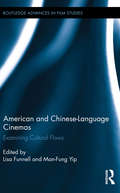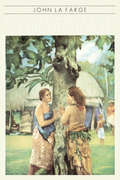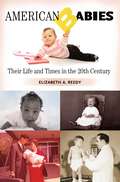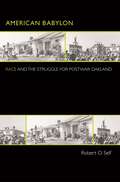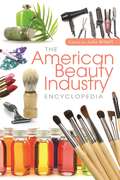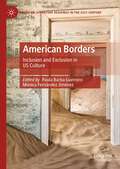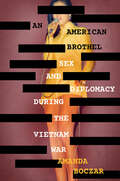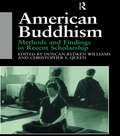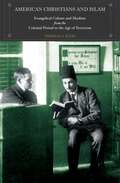- Table View
- List View
American and Chinese-Language Cinemas: Examining Cultural Flows (Routledge Advances in Film Studies)
by Lisa Funnell Man-Fung YipCritics frequently describe the influence of "America," through Hollywood and other cultural industries, as a form of cultural imperialism. This unidirectional model of interaction does not address, however, the counter-flows of Chinese-language films into the American film market or the influence of Chinese filmmakers, film stars, and aesthetics in Hollywood. The aim of this collection is to (re)consider the complex dynamics of transnational cultural flows between American and Chinese-language film industries. The goal is to bring a more historical perspective to the subject, focusing as much on the Hollywood influence on early Shanghai or postwar Hong Kong films as on the intensifying flows between American and Chinese-language cinemas in recent decades. Contributors emphasize the processes of appropriation and reception involved in transnational cultural practices, examining film production, distribution, and reception.
American and Chinese-Language Cinemas: Examining Cultural Flows (Routledge Advances in Film Studies)
by Lisa Funnell Man-Fung YipCritics frequently describe the influence of "America," through Hollywood and other cultural industries, as a form of cultural imperialism. This unidirectional model of interaction does not address, however, the counter-flows of Chinese-language films into the American film market or the influence of Chinese filmmakers, film stars, and aesthetics in Hollywood. The aim of this collection is to (re)consider the complex dynamics of transnational cultural flows between American and Chinese-language film industries. The goal is to bring a more historical perspective to the subject, focusing as much on the Hollywood influence on early Shanghai or postwar Hong Kong films as on the intensifying flows between American and Chinese-language cinemas in recent decades. Contributors emphasize the processes of appropriation and reception involved in transnational cultural practices, examining film production, distribution, and reception.
The American and Japanese Auto Industries in Transition: Report of the Joint U.S.–Japan Automotive Study
by Robert E. Cole & Taizo YakushijiThis report was prepared for the Policy Board by the U.S. and Japanese research staffs of the Joint U.S.–Japan Automotive Study under the general direction of Professors Paul W. McCracken and Keichi Oshima, with research operations organized and coordinated by Robert E. Cole on the U.S. side, in close communication with the Taizo Yakushiji on the Japanese side. [preface] In view of the importance of stable, long-term economic relationships between Japan and the United States, automotive issues have to be dealt with in ways consistent with the joint prosperity of both countries. Furthermore, the current economic friction has the potential to adversely affect future political relationships. Indeed, under conditions of economic stagnation, major economic issues inevitably become political issues. With these considerations in mind, the Joint U.S.–Japan Automotive Study project was started in September 1981 to determine the conditions that will allow for the prosperous coexistence of the respective automobile industries. During this two-year study, we have identified four driving forces that will play a major role in determining the future course of the automotive industry of both countries. These are: (1) consumers’ demands and aspirations vis-à-vis automobiles; (2) flexible manufacturing systems (FMS); (3) rapidly evolving technology; and (4) the internationalization of the automotive industry. [exec. summary]
American and Muslim Worlds before 1900 (Islam of the Global West)
by John Ghazvinian Arthur Mitchell FraasAmerican and Muslim Worlds before 1900 challenges the prevailing assumption that when we talk about "American and Muslim worlds", we are talking about two conflicting entities that came into contact with each other in the 20th century. Instead, this book shows there is a long and deep seam of history between the two which provides an important context for contemporary events -- and is also important in its own right. Some of the earliest American Muslims were the African slaves working in the plantations of the Carolinas and Latin America. Thomas Jefferson, a slaveholder himself, was frequently called an "infidel" and suspected of hidden Muslim sympathies by his opponents. Whether it was the sale of American commodities in Central Asia, Ottoman consuls in Washington, orientalist themes in American fiction, the uprisings of enslaved Muslims in Brazil, or the travels of American missionaries in the Middle East, there was no shortage of opportunities for Muslims and inhabitants of the Americas to meet, interact and shape one another from an early period.
American and Muslim Worlds before 1900 (Islam of the Global West)
American and Muslim Worlds before 1900 challenges the prevailing assumption that when we talk about "American and Muslim worlds", we are talking about two conflicting entities that came into contact with each other in the 20th century. Instead, this book shows there is a long and deep seam of history between the two which provides an important context for contemporary events -- and is also important in its own right. Some of the earliest American Muslims were the African slaves working in the plantations of the Carolinas and Latin America. Thomas Jefferson, a slaveholder himself, was frequently called an "infidel" and suspected of hidden Muslim sympathies by his opponents. Whether it was the sale of American commodities in Central Asia, Ottoman consuls in Washington, orientalist themes in American fiction, the uprisings of enslaved Muslims in Brazil, or the travels of American missionaries in the Middle East, there was no shortage of opportunities for Muslims and inhabitants of the Americas to meet, interact and shape one another from an early period.
American Anti-Nuclear Activism, 1975-1990: The Challenge of Peace (Palgrave Studies in the History of Social Movements)
by K. HarveyLooking at national peace organizations alongside lesser-known protest collectives, this book argues that anti-nuclear activists encountered familiar challenges common to other social movements of the late twentieth century.
American Apartheid: Segregation and the Making of the Underclass
by Douglas MasseyThis powerful and disturbing book clearly links persistent poverty among blacks in the United States to the unparalleled degree of deliberate segregation they experience in American cities. American Apartheid shows how the black ghetto was created by whites during the first half of the twentieth century in order to isolate growing urban black populations. It goes on to show that, despite the Fair Housing Act of 1968, segregation is perpetuated today through an interlocking set of individual actions, institutional practices, and governmental policies. In some urban areas the degree of black segregation is so intense and occurs in so many dimensions simultaneously that it amounts to “hypersegregation.” Douglas Massey and Nancy Denton demonstrate that this systematic segregation of African Americans leads inexorably to the creation of underclass communities during periods of economic downturn. Under conditions of extreme segregation, any increase in the overall rate of black poverty yields a marked increase in the geographic concentration of indigence and the deterioration of social and economic conditions in black communities. As ghetto residents adapt to this increasingly harsh environment under a climate of racial isolation, they evolve attitudes, behaviors, and practices that further marginalize their neighborhoods and undermine their chances of success in mainstream American society. This book is a sober challenge to those who argue that race is of declining significance in the United States today.
American Artist In The South Sea
by John La FargeThe American artists John La Farge preceded Gauguin to the Pacific, and in their time his reputation as the modern Pacific painter far overshadowed that of the Frenchman. This remarkable work is the record of a year-long artistic odyssey through the South Seas, during which La Farge braved the volcanoes of Hawaii, visited Robert Louis Stevenson in Samoa, was adopted by a noble Tahitian family and journeyed through the wild hills of Fiji, painting and sketching lyrical studies of island life. Lavishly illustrated with his work, this account of the Polynesian adventures that La Farge shared with his friend the historian Henry Adams is an important contribution to the literary and artistic heritage of the Pacific and a revealing insight into the life of a complex and fascinating man.
American Artist In The South Sea
by John La FargeThe American artists John La Farge preceded Gauguin to the Pacific, and in their time his reputation as the modern Pacific painter far overshadowed that of the Frenchman. This remarkable work is the record of a year-long artistic odyssey through the South Seas, during which La Farge braved the volcanoes of Hawaii, visited Robert Louis Stevenson in Samoa, was adopted by a noble Tahitian family and journeyed through the wild hills of Fiji, painting and sketching lyrical studies of island life. Lavishly illustrated with his work, this account of the Polynesian adventures that La Farge shared with his friend the historian Henry Adams is an important contribution to the literary and artistic heritage of the Pacific and a revealing insight into the life of a complex and fascinating man.
AMERICAN AVANT-GARDE C
by Rebecca A. SheehanCan films philosophize rather than simply represent philosophical ideas developed outside of the cinematic medium? Taking up this crucial question for the emergent field of film philosophy, American Avant-Garde Cinema's Philosophy of the In-Between argues that the films of the American avant-garde do in fact do philosophy and illuminates the ethical stakes of their aesthetic interventions. Author Rebecca A. Sheehan contends that American avant-garde cinema's characteristic self-reflexivity is an interrogation of the modes and stakes of our engagement with the world on and beyond the screen. The book demonstrates this with the theory of the in-between: a pervasive figure that helps clarify how avant-garde cinema's reflections on the creation of images construct an ethics of perception itself, a responsibility to perpetuate thought in an enduring re-encounter with the world and with meaning's unfinished production. The book is structured by a taxonomy of the multiple in-betweens evident in American avant-garde filmmaking. Rather than systematically seeking reproductions of particular philosophers' ideas in avant-garde films, Sheehan derives categories of analysis and the philosophical claims they disclose from close readings of the films themselves. This methodology opposes mapping preconfigured philosophical concepts and values onto these films, as too many philosophical approaches to cinema have done, silencing the philosophies uniquely articulated by these films in the interest of making them ventriloquize philosophies advanced elsewhere. The chapters of this book trace three modes of the in-between that function philosophically in American avant-garde cinema: the material, the dimensional, and the conceptual. Although the chapters are organized around discrete aesthetic and philosophical preoccupations that unify several filmmakers, these three presentations of the in-between cut through all the chapters, allowing the subjects of each to converse over the course of the book.
American Avant-Garde Cinema's Philosophy of the In-Between
by Rebecca A. SheehanCan films philosophize rather than simply represent philosophical ideas developed outside of the cinematic medium? Taking up this crucial question for the emergent field of film philosophy, American Avant-Garde Cinema's Philosophy of the In-Between argues that the films of the American avant-garde do in fact do philosophy and illuminates the ethical stakes of their aesthetic interventions. Author Rebecca A. Sheehan contends that American avant-garde cinema's characteristic self-reflexivity is an interrogation of the modes and stakes of our engagement with the world on and beyond the screen. The book demonstrates this with the theory of the in-between: a pervasive figure that helps clarify how avant-garde cinema's reflections on the creation of images construct an ethics of perception itself, a responsibility to perpetuate thought in an enduring re-encounter with the world and with meaning's unfinished production. The book is structured by a taxonomy of the multiple in-betweens evident in American avant-garde filmmaking. Rather than systematically seeking reproductions of particular philosophers' ideas in avant-garde films, Sheehan derives categories of analysis and the philosophical claims they disclose from close readings of the films themselves. This methodology opposes mapping preconfigured philosophical concepts and values onto these films, as too many philosophical approaches to cinema have done, silencing the philosophies uniquely articulated by these films in the interest of making them ventriloquize philosophies advanced elsewhere. The chapters of this book trace three modes of the in-between that function philosophically in American avant-garde cinema: the material, the dimensional, and the conceptual. Although the chapters are organized around discrete aesthetic and philosophical preoccupations that unify several filmmakers, these three presentations of the in-between cut through all the chapters, allowing the subjects of each to converse over the course of the book.
American Babies: Their Life and Times in the 20th Century (Growing Up: History of Children and Youth)
by Elizabeth A. ReedyThe focus of this book is the journey babies have made over the past century. The rise of the middle class in America dictated major changes in the ways babies were fed, cared for, and raised. Social programs focused on improving water and sanitation programs for all, which led directly to decreased infection among infants and improved morbidity and mortality rates. Other programs also focused attention on babies. Advances in medicine allowed infants to be immunized against once-deadly and disabling diseases and to survive congenital defects, premature birth, and infectious disease. Physicians helped infertile couples conceive and carry a baby to term. Prenatal care helped mothers give birth to a healthy baby. Early intervention services gave infants an advantage as they faced growing up in the modern era. Today, most American babies are better off than they were in 1901. Overall they are bigger, healthier, and much more likely to survive the first year. But challenges remain. By reviewing the events of the past century, Reedy hopes we can make even more of a difference in the lives of American babies in the century to come.In 1900, most babies were born at home. Infant mortality was high and most families could expect to lose one or more of their babies within the first year of life. A family was expected to have babies, and they were certainly wanted in most situations, however, they did not generally receive the attention they do today. In the early years of the 21st century, the birth of a baby is a time of joy for most parents and extended families. Birth occurs most often in a hospital delivery room with the father and sometimes other family members present. While the infant mortality rate in the United States still lags behind many other developed countries, it has significantly improved over the past century, and infant death is not a family expectation.The main focus of this book is the journey babies have made over the past century. The rise of the middle class in America dictated major changes in the ways babies were fed, cared for, and raised. No longer a financial necessity as in an agrarian society, babies became a symbol of middle class prosperity and parents basked in the reflected glow. Social programs, authorized and regulated by federal and state government, became a reality. Progressive Era reformers focused on improving water and sanitation programs for all, which led directly to decreased infection among infants and improved the dismal morbidity and mortality rates prevalent among all social classes. Other programs, such as the Shepard-Towner Act, the Social Security Act, and Lyndon Johnson's Great Society initiatives also focused attention on babies. Advances in medicine allowed infants to be immunized against once-deadly and disabling diseases and to survive congenital defects, premature birth, and infectious disease. Physicians discovered the means to help infertile couples conceive and carry a baby to term. Prenatal care helped mothers prepare for the birth of a healthy baby. Early intervention services by educators, social workers, and others gave infants an advantage as they faced growing up in the modern era.At the beginning of the 21st century, most American babies are better off than they were in 1901. Overall they are bigger, healthier, and much more likely to survive the first year. But challenges remain. By reviewing the events of the past century, Reedy hopes we can make even more of a difference in the lives of American babies in the century to come.
American Babylon: Race and the Struggle for Postwar Oakland
by Robert O. SelfAs the birthplace of the Black Panthers and a nationwide tax revolt, California embodied a crucial motif of the postwar United States: the rise of suburbs and the decline of cities, a process in which black and white histories inextricably joined. American Babylon tells this story through Oakland and its nearby suburbs, tracing both the history of civil rights and black power politics as well as the history of suburbanization and home-owner politics. Robert Self shows that racial inequities in both New Deal and Great Society liberalism precipitated local struggles over land, jobs, taxes, and race within postwar metropolitan development. Black power and the tax revolt evolved together, in tension. American Babylon demonstrates that the history of civil rights and black liberation politics in California did not follow a southern model, but represented a long-term struggle for economic rights that began during the World War II years and continued through the rise of the Black Panthers in the late 1960s. This struggle yielded a wide-ranging and profound critique of postwar metropolitan development and its foundation of class and racial segregation. Self traces the roots of the 1978 tax revolt to the 1940s, when home owners, real estate brokers, and the federal government used racial segregation and industrial property taxes to forge a middle-class lifestyle centered on property ownership. Using the East Bay as a starting point, Robert Self gives us a richly detailed, engaging narrative that uniquely integrates the most important racial liberation struggles and class politics of postwar America.
American Babylon: Race and the Struggle for Postwar Oakland (PDF)
by Robert O. SelfAs the birthplace of the Black Panthers and a nationwide tax revolt, California embodied a crucial motif of the postwar United States: the rise of suburbs and the decline of cities, a process in which black and white histories inextricably joined. American Babylon tells this story through Oakland and its nearby suburbs, tracing both the history of civil rights and black power politics as well as the history of suburbanization and home-owner politics. Robert Self shows that racial inequities in both New Deal and Great Society liberalism precipitated local struggles over land, jobs, taxes, and race within postwar metropolitan development. Black power and the tax revolt evolved together, in tension. American Babylon demonstrates that the history of civil rights and black liberation politics in California did not follow a southern model, but represented a long-term struggle for economic rights that began during the World War II years and continued through the rise of the Black Panthers in the late 1960s. This struggle yielded a wide-ranging and profound critique of postwar metropolitan development and its foundation of class and racial segregation. Self traces the roots of the 1978 tax revolt to the 1940s, when home owners, real estate brokers, and the federal government used racial segregation and industrial property taxes to forge a middle-class lifestyle centered on property ownership. Using the East Bay as a starting point, Robert Self gives us a richly detailed, engaging narrative that uniquely integrates the most important racial liberation struggles and class politics of postwar America.
The American Beauty Industry Encyclopedia
by Julie WillettThis is the first encyclopedia to focus exclusively on the many aspects of the American beauty industry, covering both its diverse origins and its global reach.The American Beauty Industry Encyclopedia is the first compilation to focus exclusively on this pervasive business, covering both its diverse origins and global reach. More than 100 entries were chosen specifically to illuminate the most iconic aspects of the industry's past and present, exploring the meaning of beauty practices and products, often while making analytical use of categories such as gender, race, sexuality, and stages of the lifecycle.Focusing primarily on the late-19th and 20th-century American beauty industry—an era of unprecedented expansion—the encyclopedia covers ancient practices and the latest trends and provides a historical examination of institutions, entrepreneurs, styles, and technological innovations. It covers, for example, the 1911 Triangle Shirtwaist Factory fire, as well as how Asian women today are having muscle fiber removed from their calves to create a more "Western" look. Entries also explore how the industry reflects social movements and concerns that are inextricably bound to religion, feminism, the health and safety of consumers and workers, the treatment of animals, and environmental sustainability.
The American Bibliography of Slavic and East European Studies: 1993
by Patt Leonard Rebecca RouthThis bibliography, first published in 1957, provides citations to North American academic literature on Europe, Central Europe, the Balkans, the Baltic States and the former Soviet Union. Organised by discipline, it covers the arts, humanities, social sciences, life sciences and technology.
The American Bibliography of Slavic and East European Studies: 1993
by Patt Leonard Rebecca RouthThis bibliography, first published in 1957, provides citations to North American academic literature on Europe, Central Europe, the Balkans, the Baltic States and the former Soviet Union. Organised by discipline, it covers the arts, humanities, social sciences, life sciences and technology.
American Borders: Inclusion and Exclusion in US Culture (American Literature Readings in the 21st Century)
by Paula Barba Guerrero Mónica Fernández JiménezAmerican Borders: Inclusion and Exclusion in US Culture provides an overview of American culture produced in a range of contexts, from the founding of the nation to the age of globalization and neoliberalism, in order to understand the diverse literary landscapes of the United States from a twenty-first century perspective. The authors confront American exceptionalism, discourses on freedom and democracy, and US foundational narratives by reassessing the literary canon and exploring ethnic literature, culture, and film with a focus on identity and exclusion. Their contributions envision different manifestations of conviviality and estrangement and deconstruct neoliberal slogans, analyzing hospitable inclusion in relation to national history and ideologies. By looking at representations of foreignness and conditional belonging in literature and film from different ethnic traditions, the volume fleshes out a new border dialectic that conveys the heterogeneity of American boundaries beyond the opposition inside/outside.
The American Bourgeoisie: Distinction and Identity in the Nineteenth Century (Palgrave Studies in Cultural and Intellectual History)
by Sven Beckert Julia B. RosenbaumThis volume engages a fundamental disciplinary question about this period in American history: how did the bourgeoisie consolidate their power and fashion themselves not simply as economic leaders but as cultural innovators and arbiters? It also explains how culture helped Americans form both a sense of shared identity and a sense of difference.
An American Brothel: Sex and Diplomacy during the Vietnam War (The United States in the World)
by Amanda BoczarIn An American Brothel, Amanda Boczar considers sexual encounters between American servicemen and civilians throughout the Vietnam War, and she places those fraught and sometimes violent meetings in the context of the US military and diplomatic campaigns.In 1966, US Senator J. William Fulbright declared that "Saigon has become an American brothel." Concerned that, as US military involvement in Vietnam increased so, too, had prostitution, black market economies, and a drug trade fueled by American dollars, Fulbright decried an arrogance of power on the part of Americans and the corrosive effects unchecked immorality could have on Vietnam as well as on the war effort. The symbol, at home and abroad, of the sweeping social and cultural changes was often the so-called South Vietnamese bar girl.As the war progressed, peaking in 1968 with more than half a million troops engaged, the behavior of soldiers off the battlefield started to impact affect the conflict more broadly. Beyond the brothel, shocking revelations of rapes and the increase in marriage applications complicated how the South Vietnamese and American allies cooperated and managed social behavior. Strictures on how soldiers conducted themselves during rest and relaxation time away from battle further eroded morale of disaffected servicemen. The South Vietnamese were loath to loosen moral restrictions and feared deleterious influence of a permissive wWestern culture on their society.From the consensual to the coerced, sexual encounters shaped the Vietnam War. Boczar shows that these encounters—sometimes facilitated and sometimes banned by the US military command—restructured the South Vietnamese economy, captivated international attention, dictated military policies, and hung over diplomatic relations during and after the war.
American Buddhism: Methods and Findings in Recent Scholarship (Routledge Critical Studies in Buddhism)
by Christopher Queen Duncan Ryuken WilliamsThis is the first scholarly treatment of the emergence of American Buddhist Studies as a significant research field. Until now, few investigators have turned their attention to the interpretive challenge posed by the presence of all the traditional lineages of Asian Buddhism in a consciously multicultural society. Nor have scholars considered the place of their own contributions as writers, teachers, and practising Buddhists in this unfolding saga. In thirteen chapters and a critical introduction to the field, the book treats issues such as Asian American Buddhist identity, the new Buddhism, Buddhism and American culture, and the scholar's place in American Buddhist Studies. The volume offers complete lists of dissertations and theses on American Buddhism and North American dissertations and theses on topics related to Buddhism since 1892.
American Buddhism: Methods and Findings in Recent Scholarship (Routledge Critical Studies in Buddhism)
by Christopher Queen Duncan Ryuken WilliamsThis is the first scholarly treatment of the emergence of American Buddhist Studies as a significant research field. Until now, few investigators have turned their attention to the interpretive challenge posed by the presence of all the traditional lineages of Asian Buddhism in a consciously multicultural society. Nor have scholars considered the place of their own contributions as writers, teachers, and practising Buddhists in this unfolding saga. In thirteen chapters and a critical introduction to the field, the book treats issues such as Asian American Buddhist identity, the new Buddhism, Buddhism and American culture, and the scholar's place in American Buddhist Studies. The volume offers complete lists of dissertations and theses on American Buddhism and North American dissertations and theses on topics related to Buddhism since 1892.
American Child Bride: A History of Minors and Marriage in the United States
by Nicholas L. SyrettMost in the United States likely associate the concept of the child bride with the mores and practices of the distant past. But Nicholas L. Syrett challenges this assumption in his sweeping and sometimes shocking history of youthful marriage in America. Focusing on young women and girls--the most common underage spouses--Syrett tracks the marital history of American minors from the colonial period to the present, chronicling the debates and moral panics related to these unions.Although the frequency of child marriages has declined since the early twentieth century, Syrett reveals that the practice was historically far more widespread in the United States than is commonly thought. It also continues to this day: current estimates indicate that 9 percent of living American women were married before turning eighteen. By examining the legal and social forces that have worked to curtail early marriage in America--including the efforts of women's rights activists, advocates for children's rights, and social workers--Syrett sheds new light on the American public's perceptions of young people marrying and the ways that individuals and communities challenged the complex legalities and cultural norms brought to the fore when underage citizens, by choice or coercion, became husband and wife.
American Christians and Islam: Evangelical Culture and Muslims from the Colonial Period to the Age of Terrorism (PDF)
by Thomas S. KiddIn the wake of the September 11 terrorist attacks, many of America's Christian evangelicals have denounced Islam as a "demonic" and inherently violent religion, provoking frustration among other Christian conservatives who wish to present a more appealing message to the world's Muslims. Yet as Thomas Kidd reveals in this sobering book, the conflicted views expressed by today's evangelicals have deep roots in American history. Tracing Islam's role in the popular imagination of American Christians from the colonial period to today, Kidd demonstrates that Protestant evangelicals have viewed Islam as a global threat--while also actively seeking to convert Muslims to the Christian faith--since the nation's founding. He shows how accounts of "Mahometan" despotism and lurid stories of European enslavement by Barbary pirates fueled early evangelicals' fears concerning Islam, and describes the growing conservatism of American missions to Muslim lands up through the post-World War II era. Kidd exposes American Christians' anxieties about an internal Islamic threat from groups like the Nation of Islam in the 1960s and America's immigrant Muslim population today, and he demonstrates why Islam has become central to evangelical "end-times" narratives. Pointing to many evangelicals' unwillingness to acknowledge Islam's theological commonalities with Christianity and their continued portrayal of Islam as an "evil" and false religion, Kidd explains why Christians themselves are ironically to blame for the failure of evangelism in the Muslim world. American Christians and Islam is essential reading for anyone seeking to understand the causes of the mounting tensions between Christians and Muslims today.
American Christians and Islam: Evangelical Culture and Muslims from the Colonial Period to the Age of Terrorism (pdf)
by Thomas S. KiddIn the wake of the September 11 terrorist attacks, many of America's Christian evangelicals have denounced Islam as a "demonic" and inherently violent religion, provoking frustration among other Christian conservatives who wish to present a more appealing message to the world's Muslims. Yet as Thomas Kidd reveals in this sobering book, the conflicted views expressed by today's evangelicals have deep roots in American history. Tracing Islam's role in the popular imagination of American Christians from the colonial period to today, Kidd demonstrates that Protestant evangelicals have viewed Islam as a global threat--while also actively seeking to convert Muslims to the Christian faith--since the nation's founding. He shows how accounts of "Mahometan" despotism and lurid stories of European enslavement by Barbary pirates fueled early evangelicals' fears concerning Islam, and describes the growing conservatism of American missions to Muslim lands up through the post-World War II era. Kidd exposes American Christians' anxieties about an internal Islamic threat from groups like the Nation of Islam in the 1960s and America's immigrant Muslim population today, and he demonstrates why Islam has become central to evangelical "end-times" narratives. Pointing to many evangelicals' unwillingness to acknowledge Islam's theological commonalities with Christianity and their continued portrayal of Islam as an "evil" and false religion, Kidd explains why Christians themselves are ironically to blame for the failure of evangelism in the Muslim world. American Christians and Islam is essential reading for anyone seeking to understand the causes of the mounting tensions between Christians and Muslims today.
